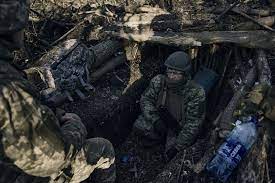There is no break for Mali’s laborers and street merchants as a catastrophic heat wave erupts over West Africa
In Bamako, the capital of Mali, street sellers sell water sachets, which are common in this region of West Africa in the summertime. Experts report that this year’s extraordinary heat wave has resulted in an increase in fatalities and warn of more sweltering weather to come as the repercussions of climate change wreak havoc throughout the continent.

As many people in this nation with a majority of Muslims commemorated the holy Islamic month of Ramadan by fasting from dawn to sunset, the heat wave started in late March.
Bamako had temperatures as high as 44 degrees Celsius (111 Fahrenheit) on Thursday, and the weather report indicates that these highs won’t be falling anytime soon.
Compared to 130 fatalities in all of April of last year, the city’s Gabriel-Touré Hospital recorded 102 deaths in the first four days of the month. The number of deaths attributable to the severe weather is unclear since the country’s military leadership forbade the release of such information.
Mali’s general director for health, Cheikh A Traoré, said that a notably higher number of older individuals had passed away during this time, despite the fact that figures are unavailable because of the measures.
Since 2020, Mali has had two coups, which have contributed to the ongoing wave of political unrest that has engulfed West and Central Africa. In addition to its political issues, the nation is facing an intensifying insurgency by extremists associated with al-Qaida and the Islamic State organization.
The Red Cross Red Crescent Climate Centre estimates that the number of heat-related fatalities this month was probably in the hundreds or thousands, but it is hard to tell for sure due to a lack of statistics in Mali and other West African nations afflicted by the heat wave.
The World Food Program reports that 1 million children under the age of five were at risk of acute malnutrition at the end of 2023 owing to prolonged warfare, internal displacement, and limited access to humanitarian supplies. The heat is further threatening the already vulnerable children in Mali.
The Associated Press was informed by Gabriel-Touré’s director of pediatrics, Professor Boubacar Togo, that the hospital had seen six instances of meningitis in youngsters in the last week—an abnormally high number. He also said that diarrhea was a common sign of a number of ailments. Togo did not provide more information or particulars.
Mali’s military authorities have reduced the school day to finish before 1 p.m. instead of 5.30 p.m. during the heat wave in order to shield youngsters from the brunt of the heat. However, laborers in Bamako claim they are forced to confront the intense heat by going outside.
Driver Amadou Coulibaly, 25, said he has two options: either he works and puts his health at danger, or he stops working for the majority of the day and gets nothing. He charges a little price for motorcycle trips.
Mali is losing a lot of international investment due to the political unrest. Fuel shortages and rolling blackouts have caused businesses to close, worsening an already severe economic situation.
Somaila Traoré, a thirty-year-old welder, toiled at his shop with twelve other workers despite the heat, pushing them to work more quickly.
He said, “We have to finish the job before the power cuts.”
According to an analysis released on Thursday by the World Weather Attribution, a global consortium of scientists studying the effects of human-induced climate change on extreme weather, the most recent heat wave in the Sahel, a region of southern Africa that experiences recurring droughts, is more than just a record-breaking Malian heat wave.
Lead author and Imperial College London researcher Clair Barnes said, “Our study found that the extreme temperatures across the region simply wouldn’t have been possible without human-caused warming.”
Maximum temperatures in Burkina Faso and Mali have reportedly increased by 1.5 degrees Celsius (2.7 degrees Fahrenheit) due to climate change, which may not have occurred “if humans had not warmed the planet by burning fossil fuels,” according to the experts.
According to the research, if temperatures continue to rise, comparable occurrences would probably occur once every 20 years.
Barnes said, “This outcome is a warning for the region and the world.” “Excessive heat can be extremely dangerous, and as the planet warms, the threat posed by it will increase.”







